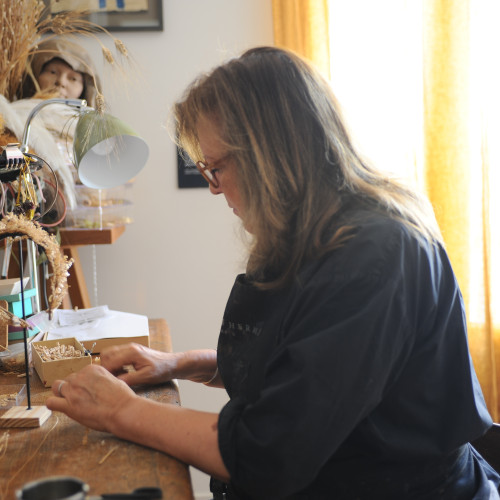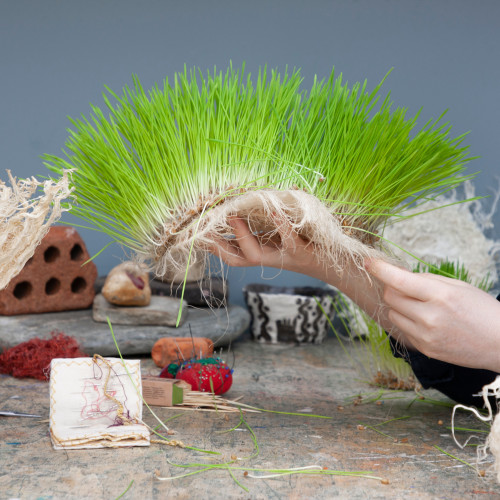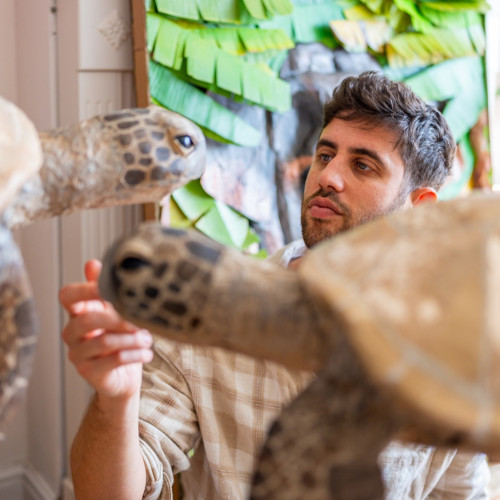
Homo Faber Guide - Leatherworker - Italy - CRAFT STORIES
Italian leatherworker Stefano Conticelli makes bespoke children’s toys, handbags and accessories for cars, boats and houses within his spacious bottega close to the Umbrian town of Orvieto. He turned to craft after falling victim to a scam that saw him lose his job, home and car. Conticelli began making toys and small pieces of homeware to make ends meet, which caught the eye of the king of cashmere, Sergio Loro Piana, whose commissions set him on a path to success. Today, he works with a team of 10 collaborators – “I don’t like to call them employees,” he says – to create one-off objects made from materials such as leather, wood, wool and copper. Each piece shows the studio’s flare for experimentation and constant pursuit of perfection. “We care about every detail – even the boxes they are packaged in,” he adds.
Many of your objects are for children. How does it make you feel to know that what you create will bring them joy?
What excites me most is the knowledge that my energy, imagination and spirit will be transmitted through the objects I make to the children who receive them. I’ve also discovered that things defined as ‘for children’ are often loved by adults too.
Is there a history of craftsmanship in your family?
My uncle Marcello Conticelli was one of the best goldsmiths in Orvieto. He was a true artist. Maurizio Gucci, then head of the Gucci fashion house, often visited him to commission objects or buy brooches and jewellery for his jackets and bags. When I was a child, watching Marcello at work in his bottega always moved me.
After you lost your job and home, how did the act of making help heal your sense of self-worth, as well as restore your livelihood?
At the time, my wife and I rented a shack outside the city. For three years we were in a state of absolute poverty with our young son. I accepted the humblest of jobs, and in my free time I crafted small objects with wood discarded from vines. I made mirrors, and sold them in local markets to survive. People liked them very much, so I slowly started to believe in myself and in my art again.
How did you turn your craft into a business?
One day I made a small truck for my nephew’s birthday and I was astonished to see him and his friends forgo their computer games and play with it like never before. I wrote letters to magazines explaining what happened and asking about the emotions that a wooden toy can elicit in a child. A journalist wrote about my work and soon, people from all over Italy – and beyond – started calling to ask for a toy truck for their kids. One day Sergio Loro Piana asked for one for his twins. From that moment, my life changed. He also commissioned me to build 10 new trucks for his boutiques in Italy and Paris. Then other commissions arrived from companies like Rolex and Vhernier.
What’s the most unusual commission you have ever received from a client?
There have been many surprises – clients have asked for everything from a luxury cashmere sleeping bag for hunting trips in the desert to leather fetish accessories, such as whips.
Has the fact that you are self-taught emboldened you to be experimental?
Absolutely. I feel free to learn different techniques, invent new ones and create my own tools. I don’t follow rules, just those defined by the material itself, such as by its hardness or its malleability. I learn from other craftsmen and I regularly experiment with new processes, working with nature. I’ve left leather in the sunshine to give it a patina or dyed it with red wine to give it a dark red hue. I once left English fustian cloth – a very rigid fabric – in seawater and then on the shoreline for 20 days. The result was a wonderful ‘new’ fabric with an aged effect. I made a capsule collection of coats, which sold out immediately.
How do you plan to pass on your skills to future generations?
This is vital for me. In April 2022, we will open the Fondazione Stefano Conticelli, a non-profit institution in the historic centre of Orvieto where students from all over the world can learn our craft. We want to safeguard making traditions and skills. The school will be housed in the Palazzo Bracci, a former hotel, so that every student will have his own private place where they can stay as long as they want.
Why do you think events like Homo Faber Event are important?
Being part of both the Homo Faber Guide and the Venice event feels like an arrival – I find myself among the best craftspeople in the world – but also a point of departure, pushing me to be even better. It’s a privilege to live and breathe Homo Faber’s philosophy.
Discover Stefano Conticelli’s profile and more talents on Homo Faber Guide
User guide:
Homo Faber Guide is structured into different sections: Discover, Visit, Experience, Itineraries and Ambassadors.
Discover: Find a selection of the best master artisans and rising talents, ateliers and manufacturers of excellence from all over Europe and beyond. Connect with them directly through the guide.
Visit: Find museums, galleries and shops linked to craftsmanship.
Experience: Find a curated list of workshop visits, artisan master classes, guided tours, and temporary exhibitions.
Itineraries: Follow a curated and themed craft itinerary or create your own.
Ambassadors: Renowned individuals and partner institutions who recommend their favourite artisans, galleries and experiences in their home cities and countries.
Subcategories: search by country, city, craft or material.
Notes for editors
#HomoFaberWay #ExperienceExcellence
@homofaber
Homo Faber Guide places craftsmanship at your fingertips. Curated by the Michelangelo Foundation, it is an online, searchable platform, which showcases artisans, ateliers, manufacturers, museums, galleries and experiences linked to contemporary craftsmanship in Europe and beyond. The platform connects craft enthusiasts, collectors, clients, curious travellers and designers with crafting excellence. Discover over 1800 talented artisans, from glass blowers to mask makers, paper sculptors to silversmiths. Newly selected artisans appear weekly, and new countries are added every three months. homofaber.com or download the app Homo Faber on the Apple Store or Google Play Store.
The Michelangelo Foundation for Creativity and Craftsmanship is a non-profit institution based in Geneva which champions contemporary craftspeople worldwide with the aim of promoting a more human, inclusive and sustainable future. The foundation seeks to highlight the connections between craft, the wider arts and the design world. Its mission is to both celebrate and preserve craftsmanship and its diversity of makers, materials and techniques, by increasing craft’s everyday recognition and its viability as a professional path for the next generations. From engaging educational programmes such as the Summer School to its signature digital project the Homo Faber Guide and international exhibition the Homo Faber Event, the foundation is fostering a cultural movement centred on master artisans and rising stars.

Homo Faber Biennial - 2024 - Artisan Portrait
May 2024

Homo Faber Biennial - 2024 - Artisan Portrait
May 2024

Homo Faber Biennial - 2024 - Artisan Portrait
May 2024